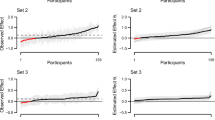Abstract
This article develops a variant of the expected utility model termed prospective reference theory. Although the standard model occurs as a limiting case, the general approach is that individuals treat stated experimental probabilities as imperfect information. This model is applied to a wide variety of aberrant phenomena, including the Allais paradox, the overweighting of low-probability events, the existence of premiums for certain elimination of risks, and the representativeness heuristic. The prospective reference theory model predicts most of the observed behavioral patterns rather than being potentially reconcilable with such phenomena.
Similar content being viewed by others
References
AllaisMaurice. (1953). “Le Comportement de l'Homme Rationnel Devant le Risque: Critique des Postulats et Axioms de l'Ecole Americaine”, Econometrica 21, 503–546.
ArrowKenneth. (1971). Essays in the Theory of Risk-Bearing. Chicago: Markham Publishing Co.
ArrowKenneth. (1982). “Risk Perception in Psychology and Economics”, Economic Inquiry 20, 1–9.
BellDavid. (1982). “Regret in Decision Making under Uncertainty”, Operations Research 30, 961–981.
EinhornHillel, and RobinHogarth. (1985). “Ambiguity and Uncertainty in Probabilistic Inference”, Psychological Review 92, 433–461.
EinhornHillel, and RobinHogarth. (1986). “Decision Making under Ambiguity”, Journal of Business 59, S225-S250.
EllsbergDaniel. (1961). “Risk, Ambiguity, and the Savage Axioms”, Quarterly Journal of Economics LXXV, 643–669.
FischhoffBaruch, et. al. (1981). Acceptable Risk. Cambridge: Cambridge University Press.
FischhoffBaruch, and R.Beyth-Marom. (1983). “Hypothesis Evaluation from a Bayesian Perspective”, Psychological Review 70, 239–260.
GretherDavid. (1980). “Bayes Rule as a Descriptive Model: The Representativeness Heuristic”, Quarterly Journal of Economics XCV, 537–557.
HogarthRobin, and HowardKunreuther. (1985). “Ambiguity and Insurance Decisions”, American Economic Review Papers and Proceedings 75, 386–390.
JohnsonNorman L., and SamuelKotz. (1972). Distributions in Statistics: Continuous Multivariate Distributions. New York: Wiley.
KahnemanDaniel, and AmosTversky. (1979). “Prospect Theory: An Analysis of Decision under Risk”, Econometrica 47, 263–291.
KahnemanDaniel, and AmosTversky. (1982). “The Psychology of Preferences”, Scientific American 246, 160–173.
KunreutherHoward, et. al. (1978). Disaster Insurance Protection. New York: Wiley-Interscience.
LichtensteinSara, et. al. (1978). “Judged Frequency of Lethal Events”, Journal of Experimental Psychology: Human Learning and Memory 4, 551–578.
LuceR. Duncan, and HowardRaiffa. (1957). Games and Decisions. New York: John Wiley and Sons.
MachinaMark. (1982). “Expected Utility Analysis without the Independence Axiom”, Econometrica 50 277–323.
RaiffaHoward. (1968). Decision Analysis. Reading: Addison-Wesley.
RaiffaHoward. (1961). “Risk, Ambiguity, and the Savage Axioms: Comment”, Quarterly Journal of Economics LXXV, 690–694.
SavageLeonard J. (1972). The Foundations of Statistics. (Second revised edition). New York: Dover Publications.
TverskyAmos, and DanielKahneman. (1986). “Rational Choice and the Framing of Decisions”, Journal of Business 59, S251-S278. Cambridge: Cambridge University Press.
TverskyAmos, and DanielKuhneman. (1986). “Rational Choice and the Framing of Decisions”, Journal of Business 59, S251-S278.
ViscusiW. Kip. (1985). “A Bayesian Perspective on Biases in Risk Perception”, Economic Letters 17, 59–62.
ViscusiW. Kip. (1985). “Are Individuals Bayesian Decision Makers?” American Economic Review 75, 381–385.
ViscusiW. Kip, and WesleyA. Magat. (1987). Learning about Risk: Consumer and Worker Responses to Hazard Warnings. Cambridge: Harvard University Press.
ViscusiW. Kip, WesleyA. Magat, and JoelHuber. (1987). “An Investigation of the Rationality of Consumer Valuations of Multiple Health Risks, Rand Journal of Economics 18, 465–479.
ViscusiW. Kip, and CharlesO'Connor. (1984). “Adaptive Responses to Chemical Labeling: Are Workers Bayesian Decision Makers?” American Economic Review 74, 942–956.
vonNeumannJohn, and OskarMorgenstern. (1953). Theory of Games and Economic Behavior. (Third edition). New York: John Wiley and Sons.
ZeckhauserRichard. (1986). “Behavioral Versus Rational Economics: What You See Is What You Conquer”, Journal of Business 59, S435-S449.
Author information
Authors and Affiliations
Additional information
Kenneth Arrow and Robert Viscusi provided helpful comments. A preliminary version of this article was presented at the 1987 AEA meetings.
Rights and permissions
About this article
Cite this article
Viscusi, W.K. Prospective reference theory: Toward an explanation of the paradoxes. J Risk Uncertainty 2, 235–263 (1989). https://doi.org/10.1007/BF00209389
Issue Date:
DOI: https://doi.org/10.1007/BF00209389




